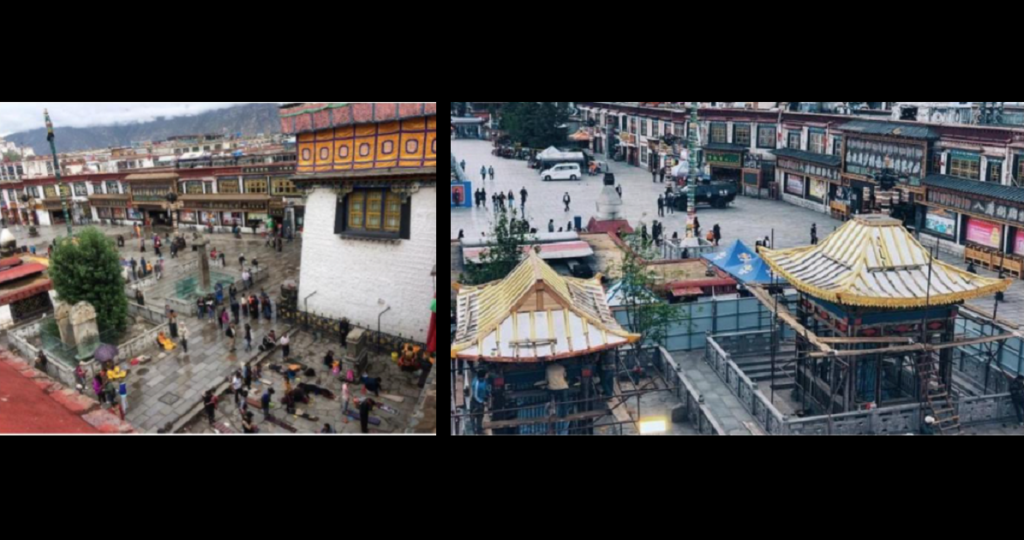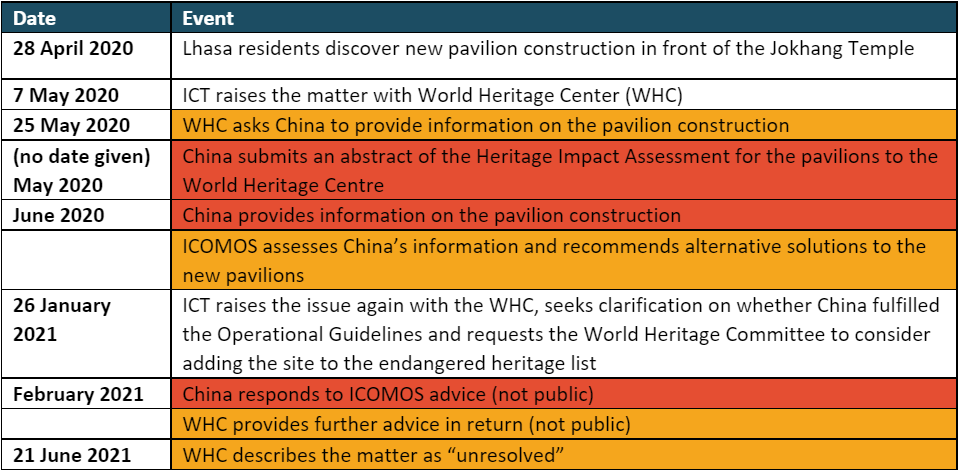
Before and after shots of the Jokhang Temple entrance dated 2014 (left) and May 2020 (right) by Tsering Woeser[1]
This year’s review of the historical ensemble of the Potala Palace is of particular interest, as there is mounting evidence of mismanagement and institutional disregard for the cultural heritage of Tibet— both serious threats to what UNESCO terms the “Outstanding Universal Value” of the site and sufficient reason to inscribe the site as “Heritage in Danger.” The review, previously scheduled for 2020, was also postponed due to the COVID-19 pandemic and is notably being hosted in Fuzhou, China. As a result, a discussion of the Potala site is unlikely due to the host country’s political sensitivities. Despite this limitation, it is important to review the historical management of the site, sustain efforts and continue to pressure the World Heritage Committee to fulfil the mission of the World Heritage Convention and apply the Operational Guidelines, which set out the criteria for effective management of a UNESCO-protected site.
A concerning response to the 2018 Jokhang fire
First, there is still uncertainty about the February 2018 fire that engulfed the Jokhang Temple. Very little information is known about the cause, effects and response to the fire. Although a Reactive Monitoring Mission in 2019 concluded that “the 2018 fire did not affect the whole of the structures, art, or belief system of the Jokhang Temple,”[2] there still remains a high level of secrecy around the incident. Even China’s required 2019 “state of conservation report” about the site was not publicized until the International Campaign for Tibet pressed the UNESCO World Heritage Centre on its absence. A two-page executive summary was subsequently published one month after the required date; it described minimal damage and provided no detail about a restoration or conservation plan.
The “unresolved” pavilions in front of the Jokhang Temple
Second, in 2020, China constructed two new Chinese-style pavilions directly in front of the Jokhang Temple. The construction of the two large pavilions, which stand in stark contrast to the Jokhang Temple, notably began during the first COVID-19 lockdown and only became known to the public on April 28, 2020, already near its completion.
As is customary with World Heritage Committee meetings, the UNESCO World Heritage Centre (WHC) publishes a report on the state of conservation at each site and outlines a draft decision to be considered by the committee. In its report on the historic ensemble of the Potala Palace, the WHC recommends the pavilions be redesigned “to be less visually prominent and less historically confusing.”[3] The International Council on Monuments and Sites (ICOMOS), an organization that provides technical expertise to UNESCO, also “advised that they [the pavilions] have a negative impact on the cultural setting and cultural context of the Jokhang Temple Monastery” and stated “alternative solutions should be considered.”[4]
Despite the expert advice and subsequent correspondence between China and the UNESCO World Heritage Centre, the report describes the matter over the newly constructed pavilions as “unresolved,”[5] suggesting China has failed to accept and act on the advice; another cause for serious concern. In fact, the advice by the WHC for the pavilions to be “less visually prominent” and to be “less historically confusing” appears to be a moderately put ask. The “alternative solution,” as implied by ICOMOS, could be their demolition.
Timeline: The construction of the pavilions in front of the Jokhang Temple
Heritage management without boundaries and conservation plans
Third, and perhaps one of the clearest indicators of institutional disregard for heritage management, China has failed to provide the UNESCO World Heritage Centre clearly defined boundaries for the heritage site and buffer zones for 18 years. Similarly, requests for a conservation plan for the site has been outstanding for 14 years. This means that UNESCO does not clearly know the boundaries of the heritage site, nor how its heritage will be managed into the future.
Tourists prioritized above Buddhist worshippers at the Jokhang Temple
Finally, it is important to note that the Jokhang Temple and other components of the Historic Ensemble of the Potala Palace are living culture. The buildings are not relics or museums that reflect a culture frozen in time from the past. Local Tibetans as well as pilgrims from across Tibet visit the sacred Jokhang Temple to prostrate, circumambulate, pray, give alms and gather. It is the people, their knowledge and their relationship to the site and their practices that give meaning, value and create a unique culture. However, in the name of COVID-prevention, on May 19, 2021 Chinese authorities introduced new rules to separate pilgrim and tourist visiting times and prioritize tourists.[6] New rules allow Buddhist worshippers to visit the temple between 8 am and 11:30 am (3.5 hours), while tourists may visit between noon and 7:30 pm (7.5 hours). While the WHC conservation report indicated that ICOMOS reviewed pilgrim and tourism management of the Jokhang Temple plaza, it is not clear if this included the May 19 rules.
While some may rejoice that there is at least some transparency and an attempt at accountability in the UNESCO World Heritage management system, the mission to protect cultural heritage (as outlined in the World Heritage Convention) is not genuine if the World Heritage Committee does not act on reliable information about consistent mismanagement. The World Heritage Committee member states should therefore invoke more serious measures, such as consider inscribing the site as a World Heritage in Danger. As per paragraph 179 of the Operational Guidelines,[7] the lack of conservation policy and threatening effects of regional planning projects, as well as significant loss of historical authenticity are at least three criteria that the property satisfies for inscription on the List of World Heritage in Danger.
Over the past decades, Lhasa has seen a tremendous loss of Tibetan cultural heritage. If UNESCO and its member states take their role seriously, the longstanding mismanagement of UNESCO-protected sites such as the Jokhang and the surrounding old Town of Lhasa must have consequences. If UNESCO doesn’t act, Lhasa’s UNESCO-protected sites and Tibetan cultural heritage will suffer further irreparable damage.
In the meantime the Chinese government will draw international recognition and prestige from its UNESCO sites and present itself as guardian of Tibetan cultural heritage, which it is not.
Footnotes:
[1] Facebook post by Tsering Woeser, 7 May 2020, https://www.facebook.com/woeser1959/photos/pcb.160721862155101/160721625488458/.
[2] United Nations Education, Scientific and Cultural Organization (UNESCO), 21 June 2021, ‘Item 7B of the Provisional Agenda: State of conservation of properties inscribed on the World Heritage List’, https://whc.unesco.org/archive/2021/whc21-44com-7B.Add-en.pdf, page 19.
[6] Radio Free Asia, 18 May 2021, ‘China Cuts Hours for Tibetan Buddhists at Lhasa’s Jokhang Temple to Half That of Tourists’, https://www.rfa.org/english/news/tibet/hours-05182021154715.html.
[7] World Heritage Centre, July 2012, ‘Operational Guidelines for the Implementation of the World Heritage Convention’, United Nations Education Scientific and Cultural Organisation, https://whc.unesco.org/archive/opguide12-en.pdf, paragraph 177-179.

